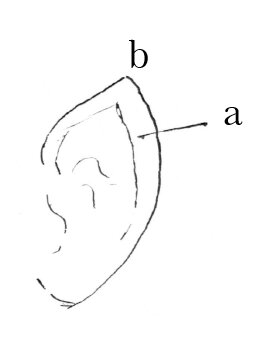From E. R. Lankester 17 April [1871]1
Nurnberger Strasse 37. | Leipzig.
April 17th.
My dear Sir,
I have got my friend Dr Nitsche to get his ear photographed—2 We spent some time with the photographer and secured, I think—the most favourable illumination, position &c.3 He was very glad of the opportunity of making himself in some way of service to you and will, I believe today forward you proofs from the photographs— The right ear has the inflected point developed—but the left ear has not got it at all—4 It looks like an ordinary ear in the photograph—rather more than it does in reality— For it has a very pointed outline (b)
 and this portion a of the helix is very broad— He has also some photographs of the ear of a foetal ourang outang belonging to Profr. Leuckart’s Museum here—which he will forward to you—5 My friend Mr Moseley of Oxford noticed in one of three Chimpanzees in the gardens at Hamburg a projecting point on the inflected margin of the helix similar to that to which you draw attention in man—6 In the other two Chimpanzees this appeared to be absent. The same friend has examined some Chrysalids of moths in consequence of your remarks as to the period of development of secondary sexual characters—7 He has made drawings of the pupæ of the Emperor moth and of the oak egger8—in both of which the male imago has an enormously larger development of the antennæ than the female imago— The pupæ of the two sexes of the Emperor moth shew scarcely any difference in the size of the case enclosing the antenna—so that in the female a small antenna is enclosed in a large case—whilst the male’s antenna fits closely to its large case. In the oak-egger the same fact is even better exhibited—for there is no difference between the male and female antennæ of the pupæ—though the enclosed imaginal antennæ differ greatly in size—that of the male being much the larger. He will send his sketches to Nature for publication—9 The German translation of the Descent of Man is just out—10
and this portion a of the helix is very broad— He has also some photographs of the ear of a foetal ourang outang belonging to Profr. Leuckart’s Museum here—which he will forward to you—5 My friend Mr Moseley of Oxford noticed in one of three Chimpanzees in the gardens at Hamburg a projecting point on the inflected margin of the helix similar to that to which you draw attention in man—6 In the other two Chimpanzees this appeared to be absent. The same friend has examined some Chrysalids of moths in consequence of your remarks as to the period of development of secondary sexual characters—7 He has made drawings of the pupæ of the Emperor moth and of the oak egger8—in both of which the male imago has an enormously larger development of the antennæ than the female imago— The pupæ of the two sexes of the Emperor moth shew scarcely any difference in the size of the case enclosing the antenna—so that in the female a small antenna is enclosed in a large case—whilst the male’s antenna fits closely to its large case. In the oak-egger the same fact is even better exhibited—for there is no difference between the male and female antennæ of the pupæ—though the enclosed imaginal antennæ differ greatly in size—that of the male being much the larger. He will send his sketches to Nature for publication—9 The German translation of the Descent of Man is just out—10
Believe me, dear Sir, | Very sincerely yours | E. Ray Lankester.
P.S. I am exceedingly glad that so great an interest is taken by the general public as evidenced by the sale of your book—in the questions discussed.11 The science-affairs of the Athenæum are now in very bad hands and are made entirely subsidiary to the notions of what will maintain its circulation—necessarily a Philistine one.12 It is amusing to see how some newspapers e.g. the Illustrated News & I think the Times—presume to discuss and pronounce on scientific problems & doctrines offhand—13
CD annotations
Footnotes
Bibliography
Descent 2d ed.: The descent of man, and selection in relation to sex. By Charles Darwin. 2d edition. London: John Murray. 1874.
Descent: The descent of man, and selection in relation to sex. By Charles Darwin. 2 vols. London: John Murray. 1871.
[Leifchild, John R.] 1871. Review of Descent. Athenæum 4 March 1871, pp. 275–7.
Summary
Has had Hinrich Nitsche’s pointed ear photographed. Nitsche also has photographed the ear of a foetal orang. [See Descent 1: 21–3.]
Letter details
- Letter no.
- DCP-LETT-7693
- From
- Edwin Ray Lankester
- To
- Charles Robert Darwin
- Sent from
- Leipzig
- Source of text
- DAR 87: 39–40
- Physical description
- ALS 4pp †
Please cite as
Darwin Correspondence Project, “Letter no. 7693,” accessed on
Also published in The Correspondence of Charles Darwin, vol. 19


